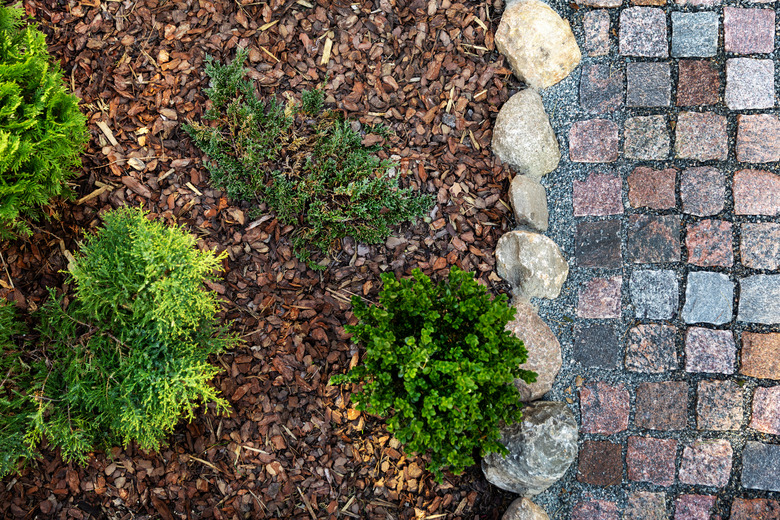What Prevents Mulch From Being Washed Away When It Rains?
We may receive a commission on purchases made from links.
Landscape mulch provides an attractive ground cover between plants or along garden paths. It also prevents weeds from growing in your garden beds while keeping the soil cooler and moister. But mulches made of lightweight materials may wash out of the bed during heavy rain if you don't install them properly or if you use the wrong type of mulching material.
Tip
Edging and lining the bed and digging down before adding mulch can help keep the mulch from washing away. Choosing a heavier type of mulch also helps.
Depth of Mulch
Depth of Mulch
Mulch that sits above the grade of the surrounding landscape washes out of the bed. When installing a mulched bed near a sidewalk or grass area, drop the soil level in the mulched area 2 to 3 inches. Adding your mulch brings this area back up to the same level as the surrounding grass or pavement and prevents the mulch materials from washing out the bed.
An exception is low-lying beds that tend to flood during heavy rains, as dropping the level may compound the flooding problem. Instead, only taper the edges of the bed to 2 inches below grade where they border the grassy or paved areas, but leave the center of the bed at its previous grade.
Edging the Bed
Edging the Bed
Installing landscape edging gives a mulched garden bed a finished look and helps keep the mulch in place, whether you drop the grade of the bed or not. It creates a slightly raised perimeter that stops the mulch from washing away. You can choose from a variety of materials and styles to fit your landscaping.
Wood and stone edging provide a natural look. Vinyl and plastic edging is an unobtrusive, inexpensive and long-lasting edging choice. Decorative edging, including those made of natural and man-made materials, protrude several inches above the surrounding landscape. Basic vinyl edging only protrudes enough to hold the mulch layer in place, typically no more than 1 to 2 inches.
Lining With Landscape Fabric
Lining With Landscape Fabric
Lined garden beds have a layer of weed-blocking landscape fabric or plastic beneath the layer of mulch. Plastic doesn't allow moisture through, so rain puddles on the surface and causes the mulch to float as the bed floods.
Using a geotextile, or landscape fabric, blocks weeds and allows the rainwater to seep into the soil beneath instead of pooling in the mulch layer. Newspaper and cardboard sheets also make a suitable short-term lining that allows moisture to seep into the soil. The newspaper breaks down within a year, so it will require replacement.
Mulch Types and Weight
Mulch Types and Weight
Light mulches wash away more easily than heavy mulches because they don't have the weight to keep them in place. If you prefer the look of wood mulch, choose pine bark nuggets instead of the lighter wood chips. The finer the texture of the wood chips, the more likely they are to wash away during heavy rain.
Pine straw mulch mats together, so it doesn't wash away easily when applied in a thick layer. Use a gravel or rock mulch in perennial beds prone to collecting water. Gravel mulch is difficult to remove, so install a layer of fabric underneath it and only use it for beds that don't require yearly replanting.
